Here are some photos from our June 7th Mass at St. Albertus.
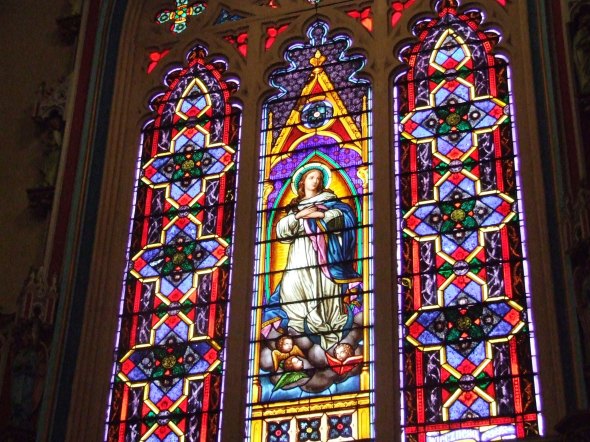
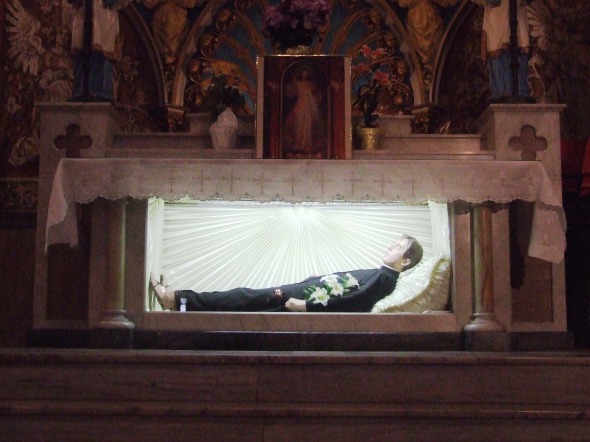
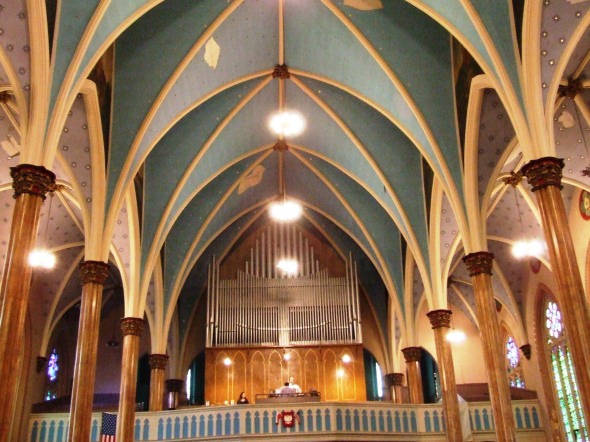
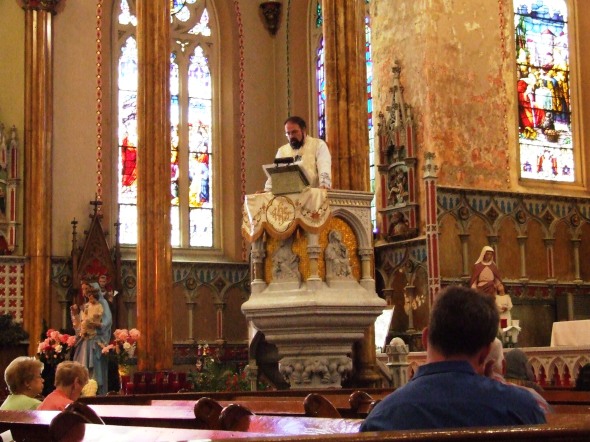
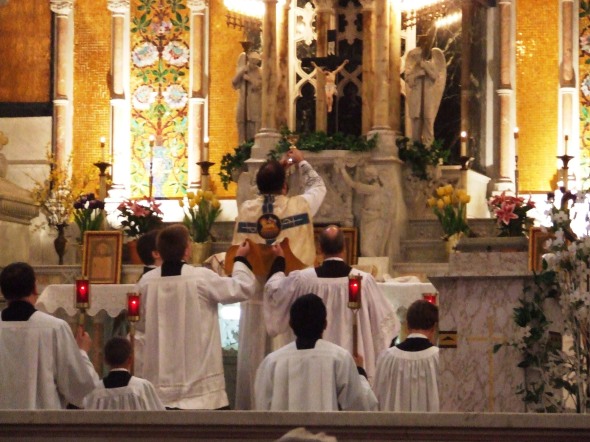
There will be more Masses done according to the Extraordinary Form at St. Albertus in the future. We will update you as time goes on.
June 28, 2009 | Categories: General | Leave a comment
A few weeks ago on May 24, we had a Baptism according to the Extraordinary Form of the Roman Rite.
The following are some photos of the Baptism held on that day. Commentary is taken from the August 5, 2007 Tridentine Community News Column.
Beginning September 14, 2007, our Holy Father, Pope Benedict XVI, will allow any priest to conduct the Sacraments of the Roman Rite in the Extraordinary (Tridentine) Form as well as in the Ordinary (Novus Ordo) Form. Even before that date, St. Josaphat Church has received permission from the Archdiocese of Detroit to celebrate the sacraments in the Old Form. This includes Baptism, Penance, Marriage, and Funerals. It is therefore appropriate that we describe the Extraordinary Form of the Sacraments, so that you may know what to expect.
We will start with Baptism, a sacrament that is celebrated rather differently from parish to parish these days. In the Classic Form, there is no variation.
As with the New Usage, the essential form of the sacrament is the minister saying, “I baptize thee in the name of the Father and of the Son and of the Holy Ghost.” In cases of necessity, the Church permits any person, lay as well as clergy, male or female, Catholic or non, to administer Baptism, as Baptism is necessary for salvation. Use of Latin is not required. The only requirement is that the person have the intent to baptize, pour water on the baptized, and say the above words.
Of course, the vast majority of the time, Baptism is a planned event, celebrated by a priest or deacon. Unlike the New Form, the Old Form presupposes the use of salt, which is blessed as part of the ceremony.
158 pages of the 1961 Rituále Románum are devoted to variations of the Baptismal ceremony, with forms for one child, multiple children, one adult, and multiple adults, as celebrated by a priest or deacon. Alternate forms are published for each of these situations when a bishop is the minister of the sacrament. Each form is strictly defined; there are no options for the minister to read from Scripture, deliver a homily, or for those in attendance to sing a hymn. Because of the set form, it is best for all participants to receive a handout delineating the sacrament and all of the responses to be made. We will make such a handout available when the time comes for our first Classic Form Baptism.
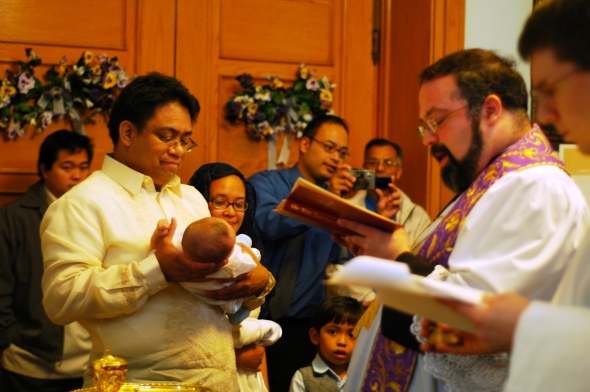
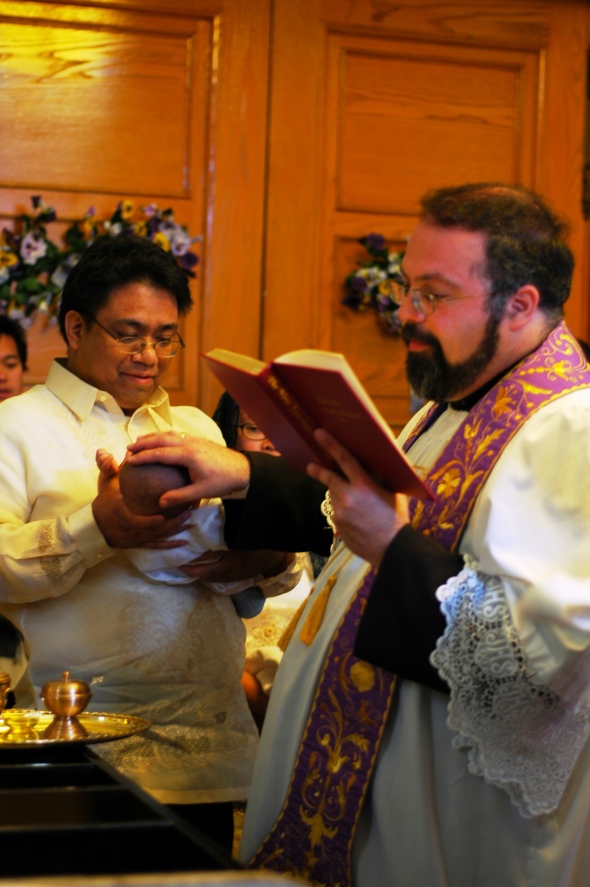
In the typical form of Baptism of one child, the ceremony opens with the minister asking the child (with the godparents responding as proxy), “What do you ask of the Church of God?” The priest then says a short prayer of exorcism and marks the forehead of the child with the Sign of the Cross.
Putting his hands on the child’s head, the celebrant prays that the Eternal Father will “free him (her) from the snares of Satan which until now have held him (her).” He then recites a prayer of exorcism and blessing of salt, which he then imposes in the child’s mouth, saying “Receive the salt, which is a symbol of wisdom.”
He then says a prayer of exorcism over the child: “I adjure thee, unclean spirit, in the name of the Father and of the Son, and of the Holy Ghost to depart and remain far away from this servant of God… And so, accursed spirit, give heed to the sentence passed upon thee. Give honor to the living and true God, give honor to Jesus Christ His Son, and to the Holy Ghost… And this sign of the Holy Cross, which we put upon his (her) forehead, do thou, foul spirit, never dare to violate.” The celebrant next prays that the child may be cleansed and given “true knowledge, so that he (she) may be made worthy of the grace of your baptism and may maintain firm hope, sound judgment, and a grasp of holy doctrine.” 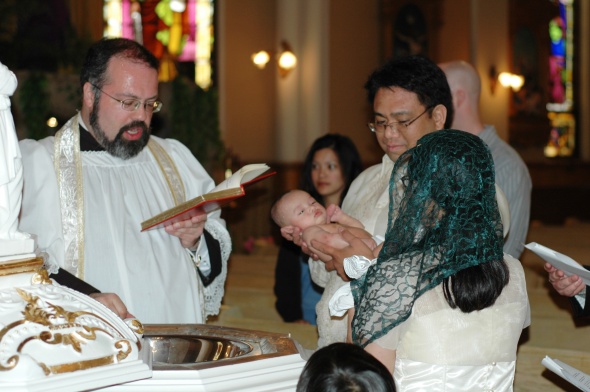
All present then recite the Apostles’ Creed and Pater Noster. Yet again, the celebrant exorcizes the child: “I adjure you, each and every unclean spirit, in the name of God the Father almighty, in the name of Jesus Christ His Son, our Lord and our Judge, and by the power of the Holy Spirit, to be gone from this image of God N., whom our Lord in His goodness has called to be His holy temple that he (she) himself (herself) may become a temple of the living God, and the Holy Ghost may dwell in him (her).” He touches the child’s ears and nostrils with his thumb, moistened with saliva, as he asks the godparents the first few Baptismal Promises in the name of the child. He then anoints the child on the breast with the Oil of Catechumens, changes from a purple stole into a white stole, and continues asking the Baptismal Promises.
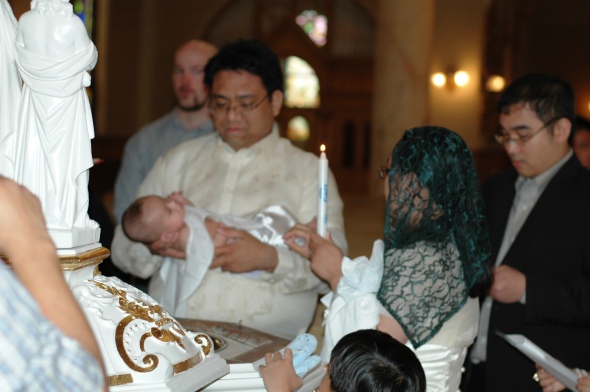
He then says the words of Baptism as he pours the baptismal water over the child three times in the form of a cross. He anoints the child with sacred Chrism on the head in the form of the cross. He wraps a white linen cloth around the child’s head as a symbol of the child’s sinless condition. Last, he gives the godparents a candle as he prays for the child to “Receive this burning light, and keep the grace of your baptism throughout a blameless life.”
The Adult form of Baptism is lengthier, beginning with the recitation of Psalms 8, 28, and 41, a Kyrie, Pater Noster, and other preparatory prayers. Numerous signs of the cross are made on the candidate, who is addressed directly in the questioning. The sponsors are not addressed as the godparents are during a child baptism. Additional prayers and exorcisms follow, more than in the child’s ceremony.
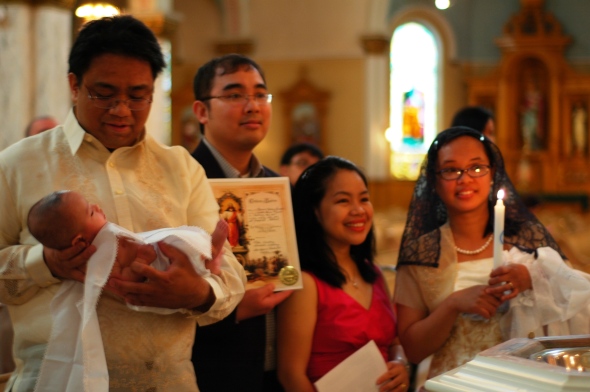
By now you have undoubtedly figured out that the key difference between the Extraordinary and Ordinary Forms of Baptism are the numerous prayers of exorcism. The New Form contains only one exorcism. This added emphasis on purifying the soul about to be baptized is perhaps more needed than ever in our modern age.
June 13, 2009 | Categories: Sacraments | Leave a comment










